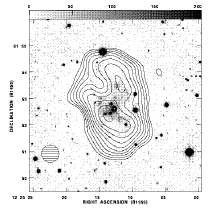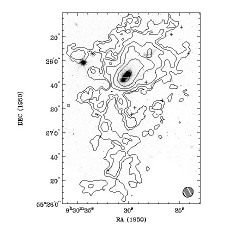HI 1225+01 (Giovanelli & Haynes 1989) is a gas rich system consisting of two major components, a north east clump (NE clump), a south west clump (SW clump) and a "Bridge" component between the two. The NE clump has an optical counterpart, a magellanic type dwarf irregular galaxy located at the center of the clump, while the SW clump has no detected stellar emission. The SW clump has an observed peak column density that is higher than that of the NE clump.
The morphology and kinematics of HI 1225+01 are qualitatively well explained as a consequence of tidal interaction between the main two components, consistent with the relative isolation of the object


